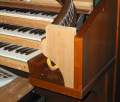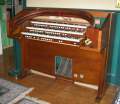|
 |
My Rodgers Trio (& MidiTzer conversion)
(518 total words in this text)
(480 reads)
The Rodgers Trio is an analogue organ having two sets of tone generators: one for the Tibia, and one for all other voices. The basic design scheme is based around the small three manual Wurlitzer organs, so, for example, the Solo manual is all 8' stops with the exception of the tibia, which is available at 16', 8', and 4'.
I have made some modifications to this model. Originally the Vox Humana was only available on the Accompaniment at 8', and I have since removed the Great 8' Kinura and replaced it with an 8' Vox Humana. Similarly, I have replaced the 16' Tuba on the Pedal with a 16' Viol, and the 8' Diapason on the Accompaniment with an 8' Tuba. Eventually I will add a few more stops, like a 16' Vox on the Great, 8' Vox on the Solo, and with the filter boards from a 33-E organ, an English Horn at 16' on the Great and 8' on the Solo.
I have repitched the 6 2/5' Tibia on the Great (originally used for the Carillon) to a 1 1/3' Larigot, which is a tad more useful. In the spirit of experimentation (and the quest for different tone colors), I've also added a 1 1/7' Septieme tibia stop on the Great.
And yet further, I have taken the individual voice output of the Viol d'Orchestre filter and run it through an Alesis NanoVerb effect processor, set on 'Chorus' to derive a very
pleasant undulating celeste, which is routed back into the organ. This particular model cannot provide a fixed frequency shift, but instead provides one which wanders
flat and sharp, either slowly or quickly, depending on how you set the controls. So, it's not a true celeste, but the effect is quite similar and nearly convincing.

Converting the Trio to a "Virtual Theatre Pipe Organ".
I'm not sure I like the "virtual' tag, perhaps simply calling it "digital" would be entirely appropriate, since that's also accurate. I'm adapting the Trio console to control a computer based organ sound-generating engine, in this case, MidiTzer.
What's MidiTzer? Basically a program you can run that emulates a theatre organ, though there's a bit more to it than that. Learn more here: MIDITZER at VirtualOrgan.com
The original MidiTzer program modeled a style 216 Wurlitzer, the biggest two manual standard Wurlitzer organ, comprising 10 ranks. With the advent of the later MidiTzer program, modeling a 19 rank organ on three manuals, with some modern unifications (but not comprehensively so), I thought I'd create a three manual console to control the functions of the enhanced MidiTzer, giving me a 'real' console for this 'virtual' organ.
Rather than trying to have a 3/19 fit into the modest confines of the Rodgers console, I settled on having, essentially a turbo-charged style 216 -- basically the 10 ranks of the 216 configuration, accessed from three manuals.
With some head-scratching, I managed to figure a backrail which allows the fitting of a few more tabs, and which only requires the console to be about an inch taller.
Here's a mock-up:

More to come...!
Update 8/11/07
Now all the work associated with acutally implementing the idea behind the mockup! I decided it would be good to have two swell pedals instead of one, so the first move was to fit two pedals in the shell.

A quick look at the newly made backrail. I'm not a heavy traps user, so the four left-most tabs are all of the traps: Pedal Bass Drum and Cymbal, Accompaniment Cymbal and Tambourine. That's it. Five trems, three miscellaneous controls (currently planned as a celeste on/off and two rank substitution controls), and three tabs for overflow from the great.

And here is the slightly narrowed stoprail in place, with newly made end cap portions.

What am I talking about with the words "slightly narrowed"? Well, the Trio console shell is so narrow, that you can't mount a standard dual-magnet stop action between the 'rear' face of the rail at the far left or right ends of the rail, and the left or right inside face of the console. So, this stoprail is narrower, left-to-right, than a normal Trio stoprail. Basically, I cut out a small section in the center of the rail, and spliced it back together without the cut-out section. I lose two tab spaces on the main rail, but since I've added 15 on the backrail, I still have a net gain of 13 stops.
Update 8/14/07
Minor adjustment to the stoprail end-cover piece. It looks vaguely Wurlitzer-ish now.

Update 8/17/07
My original 'new' piston rails were made from pieces of common molding which had a nice profile, but were pine, which is somewhat soft and not terribly fun to work with. Here I am busily boring away at a bunch of new poplar piston rails. Some people might argue that poplar isn't much of a step up from pine, and they'd be right, but it's good enough for this project!

Update 8/21/07
Newly made piston rails now stained, finished and with pistons too. Stain and finish on the stoprail end-cover pieces as well. The stain matching is not exactly perfect, but I'm not very good at that sort of thing...so, no surprise there!

Update 8/28/07
Stain and finish on the back-rail. I think the next step is to start working on getting stop actions mounted on the main rail...

Update 2/13/08
Seems like a decade later - finally some stop tablet actions on the main rail. Yay! I managed to fit 66 tabs in with somewhat tight (though not impossibly so) spacing. Next update in 2009?!?

|
[ Back to 03. Electronic Organs | Main Index ]
|
|
| |



